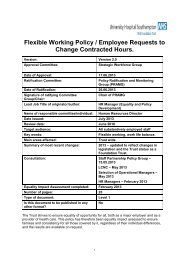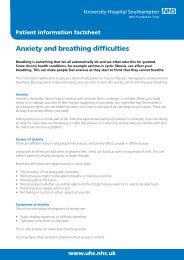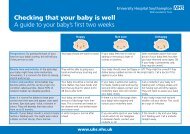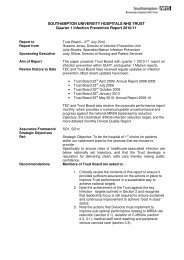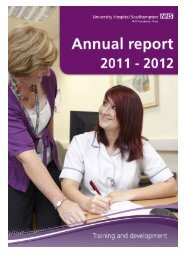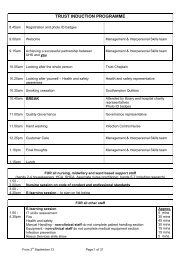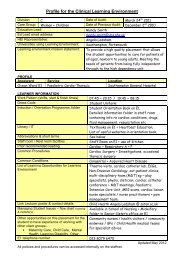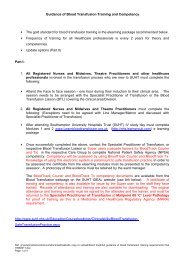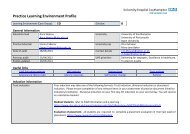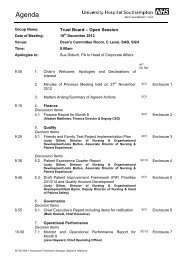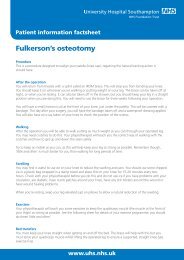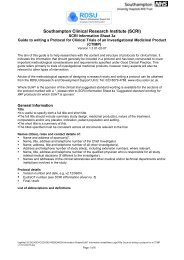ninety years of service - University Hospital Southampton NHS ...
ninety years of service - University Hospital Southampton NHS ...
ninety years of service - University Hospital Southampton NHS ...
- No tags were found...
You also want an ePaper? Increase the reach of your titles
YUMPU automatically turns print PDFs into web optimized ePapers that Google loves.
made <strong>of</strong> local convalescent homes particularly that at Testwood which closed in 1928.To be admitted, a patient now required not only a referral letter from his panel doctor but also two introductory letterswhich would last for one month though an O.P. attendance needed only one letter. A subscriber had at his disposal onesuch letter for every 10/6d subscribed. The unfortunate parents would have to hunt around for a patron with letters tospare before their child could be treated. However emergencies and accidents were treated without question. No chargeswere made and a suggestion that 2/6d be charged for a dental gas was firmly turned down. The rules at this time statedthat “Only women and children <strong>of</strong> those parents who are unable from want <strong>of</strong> means or other urgent cause, to be suitablytreated elsewhere and who after medical examination are shown to be in need <strong>of</strong> treatment are to be admitted aspatients”. One subscriber complained to the committee that a child whose father earned £7 per week should not havebeen treated at the hospital.In 1936 revised rules state that the parents <strong>of</strong> patients who could afford to do so, were to be asked to contribute towardsthe cost <strong>of</strong> treatment and maintenance. There was also mention <strong>of</strong> a Pay Bed ward but this does not appear to have beenestablished. Introductory letters were no longer required.Before the war the hospital had largely relied on subscriptions anddonations for finance but with the increased size and turnover there wasa need to find much more money. The Linen League continued to bevery active and provided not only linen but furnishings for the newnurses’ home. Pound Days also continued. The annual Carnival and flagdays were a valuable source <strong>of</strong> funds. Many <strong>of</strong> the local businessesparticularly the big shipping companies gave large donations butimportant contributions were also made by a number <strong>of</strong> working men’sorganisations notably the <strong>Southampton</strong> Tramwaymen. A ‘Penny in thePound’ scheme whereby some employers deducted that amount from aman’s wages as a form <strong>of</strong> health insurance was introduced to befollowed by other contributory schemes. Various new fund raisingschemes were introduced. A Children’s League was started in 1927 whereby individual schools in the neighbourhoodwere encouraged to support a particular named cot. In 1928 the ‘Gugnunc’ cot was endowed. This was the first <strong>of</strong> severalsuch cots ‘Named in Perpetuity’ each costing the donors £600. Probably the last to be endowed was the ‘Reid’ cot tocommemorate Flight Sgt. John Reid who had been shot down over Germany in 1944. It is sad that all the commemorativeplaques for these cots were lost when the hospital closed in 1974.In 1925 the first part <strong>of</strong> a new nurses’ home fronting Vinery Gardens was opened thus releasing accommodation in themain building for a small ‘tonsil ward’ The remaining half <strong>of</strong> the nurses’ home together with a lecture room was completedin 1931. Further expansion took place in 1927/9 The kitchen was enlarged and linked to a new ward kitchen above by a‘dumb waiter’. The Shirley Wing was added to the front <strong>of</strong> the building providing a new department for Massage, electricaland sunlight treatment together with X-ray on the ground floor and a 15 cot ward and sun balcony above, thus bringingthe total number <strong>of</strong> cots available to 45. New provision was made for the dispensary thus freeing space for a dressingsroom in Out-patients. An oxygen tent was donated in 1938. In 1928 a number <strong>of</strong> ladies volunteered to provide teaching tosome <strong>of</strong> the in-patients, The hospital was visited in 1929 by H.R.H. Prince <strong>of</strong> Wales who was surprised at its small size.In it’s Jubilee Year (1934) plans were made for a very large increase insize to provide up to 100 beds; this was to be achieved in stages over anumber <strong>of</strong> <strong>years</strong>. An appeal was organised for Stage 1 to raise £5000 -£6000 in order to build a new out-patients, a new theatre, a lift and tomake various other improvements. Number 5 Vinery Gardens waspurchased at the same time. At that time the theatre was upstairs byWard 1, The extensions were opened the following year by the Bishop <strong>of</strong>Winchester Dr Garbett, bringing the number <strong>of</strong> beds up to 55. In 1940Oakfield House a substantial Victorian building next door which had beenthe Vicarage, and later belonged to Dr H. Carter, was purchased, It washoped that this would provide additional in-patient accommodationthough in the event it was used for administrative <strong>of</strong>fices andaccommodation for senior nursing staff.At the outbreak <strong>of</strong> World War 2 the children were evacuated to Lord Mayor Treloar’s <strong>Hospital</strong> at Alton but emergenciescontinued to be admitted though they were transferred to Alton as soon as they were fit enough to be moved. Adults werealso admitted to Ward 2 but this practice ceased in 1942. The Children’s <strong>Hospital</strong> also acted as a First Aid Post and wascontinually manned by stretcher bearers during the Blitz on <strong>Southampton</strong>.During the air raids patients who were fit enough were brought down to the central corridor which had been speciallyreinforced and put to bed on benches later to be used in Casualty. Seriously ill children had to remain in the wards upstairsaccompanied by a nurse who was issued with a ‘tin hat’ for’ her’ own protection. In the event the hospital escapedany damage in the air raids though some bombs and also an enemy aeroplane fell uncomfortably close. ln 1942 DrMargaret Desser the R.M.O., herself a refugeefrom Czecho-Slovakia, and Dr K.Slaney received awards for bravery from the Ring for saving air raid casualties from the



